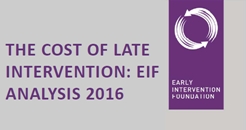 £17bn per year - the cost of late intervention
£17bn per year - the cost of late intervention
The Early Intervention Foundation recently published a report on the costs of what they call ‘late intervention’: the acute, statutory and essential benefits and services that are required when children and young people experience significant difficulties in life, many of which might have been prevented.
They estimate how much is spent each year on the following sets of issues:
-
Crime and anti-social behaviour
-
School absence and exclusion
-
Children’s social care
-
Child injuries and mental health problems
-
Youth substance misuse
-
Youth economic inactivity
Knowing what is spent on late intervention is useful because it illustrates a potential ‘fiscal prize’ from early intervention: if children at risk can be helped early on so that their needs do not become entrenched, then they are less likely to require statutory intervention or acute services later on – freeing up resources and reducing pressure on the system.
What is not counted are the costs of interventions in later life e.g. hospitalisation, incarceration, so the savings will be much greater.
They estimate that nearly £17 billion per year is spent in England and Wales by the state on the cost of late intervention. This has not fallen since their last report in 2015.
While the estimated total is as before, the latest analysis shows that the profile has changed. For example, the cost due to domestic violence has risen, while the cost due to young people who are not in employment, education or training has fallen.
Findings
Nearly £17 billion per year is spent in England and Wales by the state on the cost of late intervention.
The largest individual costs are:
-
£5.3 billion spent on Looked After Children
-
£5.2 billion associated with cases of domestic violence
-
£2.7 billion spent on benefits for young people who are not in education, employment or training (NEET)
The cost of late intervention is spread across different areas of the public sector, with the largest shares borne by:
-
local authorities (£6.4 billion)
-
the NHS (£3.7 billion)
-
DWP (£2.7 billion)
In education, the total costs of persistent absenteeism and permanent exclusions are both higher than last year’s estimate.
The amount spent on late intervention varies significantly across England. Using heat maps, they are able to show that the amount of money spent in a local authority on late intervention is, to some extent, linked to the level of deprivation in that area. There is also an urban/rural split: rural areas are more likely to show lower levels of both late intervention spend and deprivation, while urban areas are more likely to show higher levels of both.
"If we truly want to succeed in reducing crime and increasing the life chances of people in our society, we need to better tackle the root causes by intervening at the earliest opportunity. We know that crime is cyclical and that adverse childhood experiences significantly increase the chances of youngsters becoming involved in crime throughout their lives. We need to better tackle the origins of crime, rather than simply react to problems when they arise." Stephen Mold, Northamptonshire Police and Crime Commissioner.
Download the report here.
The church is ideally placed to be a catalyst in the community for helping a community become trauma-informed. See my previous blog here.
Retweet about this article:
From a report by EI Foundation, 29/11/2016